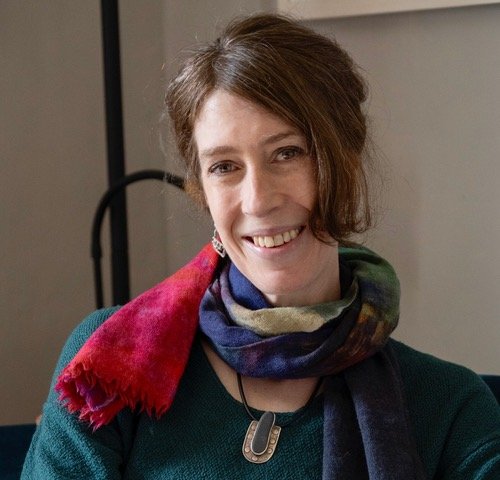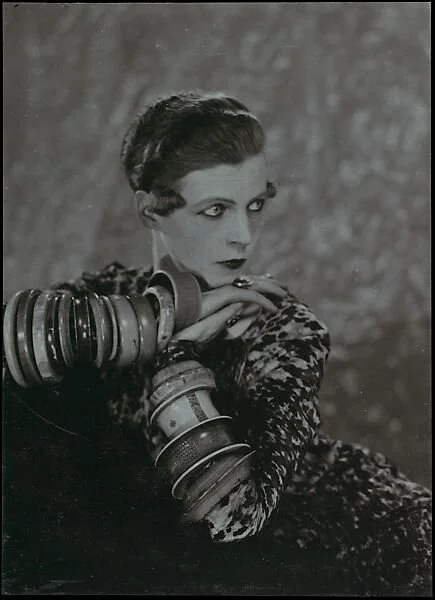Jane Griffiths - Professor, Poet and Maker
/Jane has many strings to her bow. She is an Associate Professor at the University of Oxford, and a Fellow of Wadham College, where she teaches medieval and early modern literature in English. Her research is primarily on poetry of the 15th and 16th centuries; her first book was on the early Tudor poet John Skelton.
She’s also a poet, having six books published by Bloodaxe, most recently Little Silver (2022). In the past she’s worked as a letterpress printer and lexicographer, and formally trained and worked as a bookbinder for several years. Lately she spends much more time on jewellery-making and painting, and has work in galleries in Oxfordshire and West Penwith. Bringing these things into conversation with each other is her desire.
We asked Jane about her connection to Cornwall:
“Since 2014, I spend half the year at my cottage in St Just. I’m from Exeter, was brought up in Holland but I came back to England when I was fifteen. My parents stayed in Holland and I was unofficially taken on by a family with strong historical St Ives connections, so I started spending a lot of time there.
A friend of the family put me in touch with Melissa [Hardie-Budden] and she asked me over to Newmill in the spring of 1991 - and of course, Melissa being Melissa, we became and remained friends. And I was hugely touched when Phil asked me to read at her memorial event at The Exchange.”
Poet & Cat is a showcase for Jane’s jewellery, painting and collage and other artefacts made by way of escape from her daily work with words.
Instagram: @poet.and.cat
1. What do you consider your greatest achievement?
It’s probably having got to where I am now, despite (or more probably because of) its inconsistencies: I’m happy to be part of Oxford, and very grateful to have the opportunity to teach in its tutorial system, which brilliantly fosters independent learning – but I’m equally happy to have a creative practice that’s entirely independent of the university. It feels a real achievement to be holding those things more or less in balance, and I’m probably particularly aware of how easily that might not have happened because I was brought up in Holland and taught in Dutch between the ages of eight and sixteen; when I came back to England, English was my second language and I didn’t really have a home in the country. It would have been very easy to slip through the cracks, and if I hadn’t been supported by several people who had no obligation to, I probably would have gone under. Even so, there were knock-on effects for well over a decade, and I’m astonished as well as proud to have fashioned a life in which I’m able to work and make in ways that interest me.
2. What motivates you to do what you do?
I began writing when we left England for Holland, almost certainly as a kind of compensation for being separated from my friends and from a city and landscape I’d been unquestioningly at home in. It became the only available way of making sense of the world, and I think that’s probably true still of my poetry and painting: both keep returning to houses – often lost or vanishing ones – that directly or indirectly recall my childhood home in Exeter.
Bookbinding and jewellery-making are probably rather differently motivated: there’s tremendous satisfaction in creating an object that’s entirely separate from oneself and has an independent existence. Decades ago at the London College of Printing, when my year group being taught how to cover a book in vellum, our tutor warned us that if we got a crease in the spine we’d never get it out again, and it would still be there centuries after our deaths. It was an effective warning – but I also loved the thought that traces of our making process would carry on like that.
In my academic work, I feel I’m uncovering those processes. It’s very easy to forget that even canonical works – Chaucer’s Canterbury Tales or Milton’s Paradise Lost – didn’t always exist and that someone once sat over a blank page bringing them into being in real time, not knowing whether they’d succeed. I’ve always been drawn to authors where that process is most visible; they may have been dead for over 500 years, but they feel like kin.
3. What do you owe your mother?
Language! She taught me to read at a very early age (two or three), and I’ve clear memories of her holding up flash cards for me, and then of reading to her a year or so later while she looked after my new-born brother.
And also the permission not to have children. A lot of mothers would have been pressurising, and she never was.
4. Which women inspire you and why?
I’d probably say that I ‘admired’ rather than ‘was inspired by’ – though I suppose the two shade into one another. My grandmothers, first, both of whom were very independent-spirited. And then a lot of writers and artists, for their work and for their lives. When I was thirteen or fourteen, I came across that iconic Cecil Beaton photo of Nancy Cunard – the one where she’s posed against a spotted background with a very sharp 1920s bob and enormous bracelets all the way up both arms – and I was fascinated by her very personal style. Then when I read the Anne Chisholm biography of her, I discovered she had been a poet and a printer, and she became my heroine for combining writing with craft AND with complete self-possession. Later, Woolf – again, for combining writing and printing, and also for capturing so perfectly what she called the flight of the mind. Later still, Elizabeth Bishop for her scrupulous attentiveness to her work. And Romilly Saumerez-Smith, first for her work as a binder, then as a jeweller: there’s such texture and depth in both they seem to capture the passing of time in 3D, possibly as Woolf does in words. In a different way entirely, the mothers of some of my childhood friends, especially Lottie’s mother Linda Hoare and Hannah’s mother Bernhese Woodman, for their warmth and tolerance of chaos and for evidently having lives of their own that we were on the margins of – but also seeming so easily to accommodate us.
5. What are you reading?
For work, two doctoral theses and forty-one job applications! – even though it’s the vacation and I was hoping instead to be reading the 15th-century French-English bilingual poet Charles d’Orleans. I’m also returning to another 15th-century poet, James Ryman, who uses a great deal of repetition, and thinking about what that tells us about his composition practices. Outside work, I found a copy of Elizabeth Bowen’s Bowen’s Court in a second-hand bookshop the other day, and I’m very much looking forward to re-reading that. I’ve just read Pearl by Sian Hughes – a brilliant book about childhood loss that spins off a gorgeous medieval alliterative elegy but is entirely its own thing – and Inscription by Christine Whittemore, which was another happy find along with the Bowen. I tend to get obsessed with certain books of poetry and keep them by the bed for months: at the moment it’s The Kingdom by Jane Draycott, Nigh-No-Place by Jen Hadfield and City of Departures by Helen Tookey. I also gravitate towards memoir and non-fiction that reflects on creative processes: I’ve recently been reading Polly Barton, Moyra Davey, and Sara Baume, among others.
6. What gender barriers have you had to hurdle?
That’s an interesting question. When I was young, I was very aware that both my grandmothers had to leave school in their mid-teens, whereas my parents assumed I would go to university, so (even though my father once said ‘girls aren’t really any good at science’) my sense was that the hurdles had been overcome. That sense was also fostered by being at a former men’s college as an undergraduate; it had only been mixed for 9 years when I arrived, but there didn’t seem to be any difficulties. More recently I’ve become a lot less sanguine. In the first instance that’s for personal rather than professional reasons, but it has made me more alert to a certain kind of dismissiveness professionally as well. So I suppose I feel it’s an atmosphere and a set of assumptions I’ve had to contend with, rather than specific hurdles. I’m reluctant to think that this has had much direct impact – but also suspect that I too have internalised a lot of the assumptions, and that they’ve very much coloured how I’ve presented myself.
7. How can the world be made a better place for women?
I think that varies enormously depending on where in the world you’re thinking about. At the moment of course it’s impossible not to see that some of the most fundamental things that would make it a better place for women would also make it a better place for all of humankind: the absence of violent nationalism, of terrorism, of narcissistic and manipulative politicians. How that ‘absence’ might be achieved when all those things are so powerfully present, I can’t imagine. Similarly, what would make things better for women in the ‘West’ would be an entirely different culture over the past few thousand years … But impossibilities aside, and thinking about daily life in the UK, it would be a start to work to eradicate what I the assumption shared by many men that theirs are the lives and the work that matters, and that they are and should be in control. I often see glimpses of this even in entirely decent men who’d be shocked to realise they thought that way; it’s something that’s bred in. I’m very sceptical of most aspects of our school system now, but I think it’s possible schools are attempting to do something to counter that. There are a lot of things working against them, though.
8. Describe your perfect day?
Waking in early summer with the light through the curtains showing that it’s sunny outside. Perhaps going for an early swim; certainly having nothing scheduled except perhaps a drink with friends in the evening, and having a poem and a series of paintings as work in progress which is going well. Working on them without interruption except for coffee and lunch in the garden and knowing that there are many more identical days to come, with no imminent deadlines.
9. We've noticed there really aren't many (if any) statues of women around Cornwall - who would you like to see remembered?
My immediate thought was ‘Melissa!’ [Hardie-Budden] – but she said in her Woman of the Month interview that she doesn’t think statues are a good use of money, and I’m inclined to agree. My sense is that no one really looks at them until they decide that one stands for something they disapprove of. I’d rather read, see, or learn about someone’s work than look at a representation of them. So what seems more important is a forum for bringing women’s work to wider attention – like Hypatia, of course.
10. Give us a tip?
Virginia Woolf says it best, in The Waves: ‘Let a man get up and say, Behold, this is the truth, and instantly I perceive a sandy cat filching a piece of fish in the background. Look, you have forgotten the cat, I say.’



